I need to disclose something first. For more casual use I've been trying to use a Nikon Z50. While that camera is pretty good, and was arguably better than most of its peers when it first appeared five years ago (2019), the lack of appropriate lenses and some features/performance that no longer quite stand up got me (and others) looking for alternatives.
At that "highly competent but not really top end" range of recent mirrorless cameras, we have the Canon R10 and the Fujifilm X-S20. If you go to highest point of current APS-C, you also have the recent Canon R7, Fujifilm X-T5/X-H2/X-H2s, and Sony A6700 to consider.
I wanted a solid, casual mirrorless camera that was a permanent resident in my gear closet. After much deliberation and handling in stores, I chose the X-S20. I would have chosen a Nikon Z70 if it had existed ;~). I mention all this up front because there could be a bit of bias as I approached this review: I want the X-S20 to work for my needs. As always, I'll try to call things like I find them, and point out the good with the bad, but I wanted you to know that this particular review comes about not so much because it was the next camera on my list to deal with, but because it's a camera that I'm currently using as an alternative to a missing Nikon product.
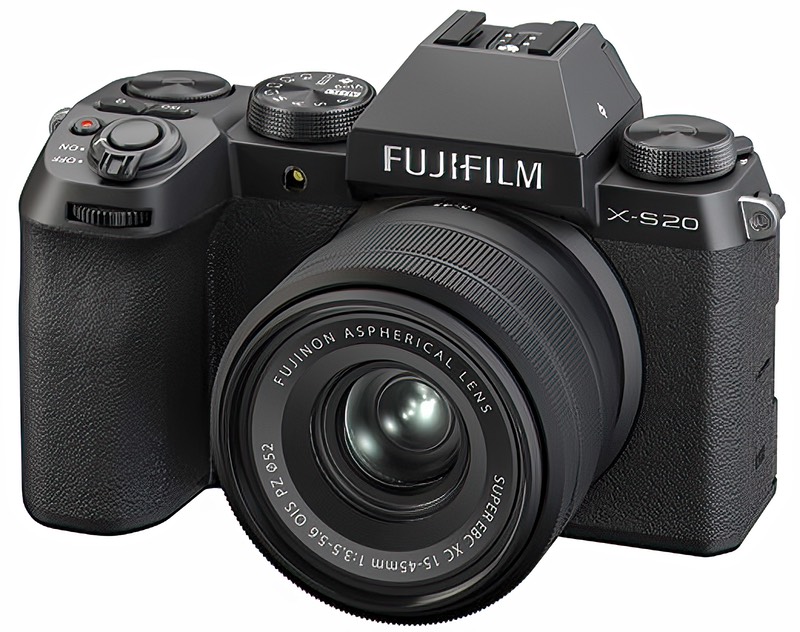
What is It?
The X-S20 is the second iteration of a somewhat different approach to cameras than Fujifilm had been taking. Fujifilm is well known for its retro dials cameras, and the X-S## line is not that. If anything, the X-S20 and its previous iteration are very button-plus-dial cameras, much in the old Nikon tradition (Canon was more overloaded button+dials, Nikon just straight up buttons+dials). Up top of the X-S20 you have a Mode dial, but no shutter speed or ISO dial. ISO is a button, and shutter speed is set with a Command dial (in the appropriate Exposure modes). Very Nikon prosumer like. If there were a Nikon name on the faceplate instead of Fujifilm, a lot of people wouldn't notice. (Okay, you might notice the Q button instead of an i button.)
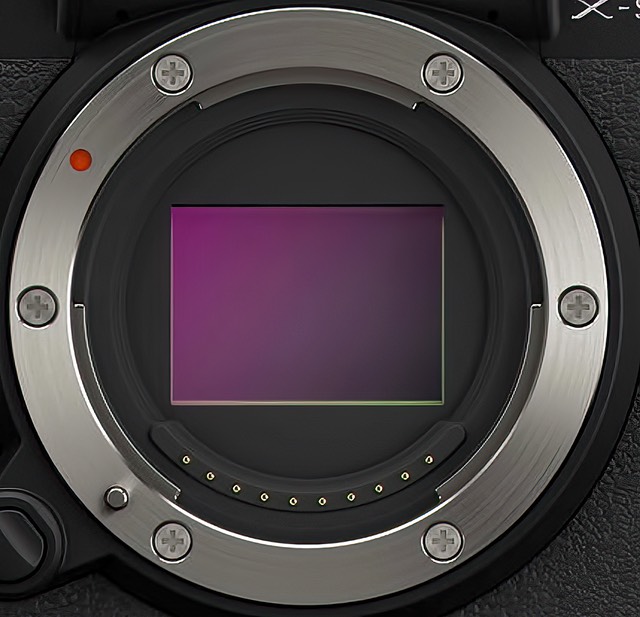
But let's start inside. There you'll find a 26.1mp BSI X-Trans 4 image sensor with an updated X-Processor 5. This is basically Fujifilm’s ongoing image sensor backed with newer central command that's faster and has more options. While that doesn't net you more pixels, you will find that the combination has plenty of things that are new: 10-bit 4:2:2 HEIF support, a new pre-shot capture mode, and lots of additional video capabilities.
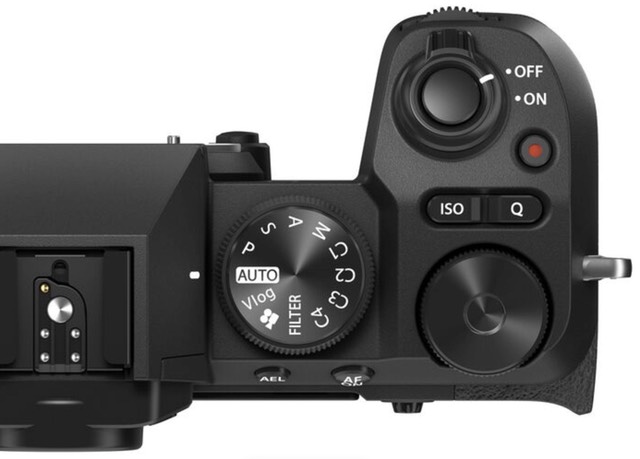
That's right, the X-S20 tries to do it all, and on the video side that means a quick VLOG mode (on the Mode dial, above), or a dedicated full control video mode, which includes 6.2K open gate video, as well as the usual up to 4K/60P (DCI or plain 16:9) and FullHD/240P options. External video via HDMI—unfortunately a micro connector—has ProRes RAW and Blackmagic Design RAW support. There’s F-Log and F-Log2 built in for serious grading ability. A microphone and headphone jack, optional cooling fan, additional digital stabilization (above and beyond the usual sensor/lens-based stabilization), and plenty of compression options (H.264 or H.265, 8-bit or 10-bit, LongGOP or ALL-I) round out the video capabilities. For a camera at the intermediate level, it's pretty full featured on the video side.
But you want to know about still photography.
That 26mp image sensor sits on a stabilization platform that provides up to 7 stops CIPA correction, derived from five-axis calculations. As with all X-Trans sensors, there's no anti-aliasing filter. 26mp nets you 6240 x 4160 files, which can be 8-bit JPEG, 10-bit HEIF, or 14-bit RAF (raw). Raw files can be uncompressed, lossless compressed, or compressed (hmm, that sounds a bit like an old Nikon menu choice, doesn't it?) If you need it, the X-S20 can even produce 8- or 16-bit TIFFs in camera from your taken raw files.
Frame rate is 8 fps for the mechanical shutter, 20 fps for the electronic shutter. You can also use 30 fps with a crop to 20.9mp output. Fujifilm claims as much as a 1000 image buffer (JPEG or compressed raw), but see performance, below.
As usual, JPEG users will find the full array of Fujifilm film simulations—Acros, Classic Chrome, Classic Negative, Eterna, Nostalgic Negative, Pro Negative, Provia, and Velvia—though I find these more suggestive than accurate. The digital Velvia, for instance, doesn’t drop to black the same way film Velvia did, and none of the others exactly match what I know to be true of the film they’re named after, either. You also have a FILTER position on the Mode dial that gives you access to Toy, Miniature, Pop Color, Hi-Key, Low-Key, Dynamic Tone, Soft Focus, and a bunch of Partial Color options, should you think of your camera as a toy to be played with. There's even a Panorama mode (buried in the Drive button choices).
If you're into "all auto", the X-S20 can accommodate that. Auto on the Mode dial gives you subject detection as well as the usual scene optimization.
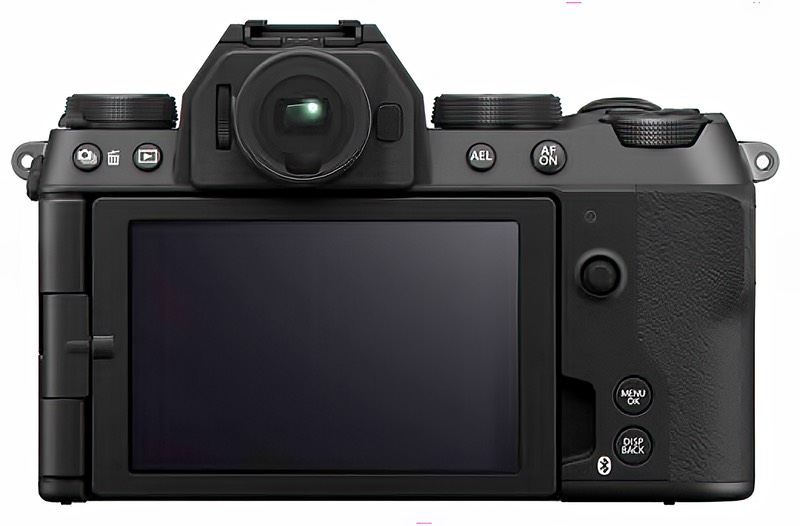
On the back of the camera sits a fully articulating 1.84m dot 3” touchscreen. Not a high end bright screen, but also not low end dim one, either. While traveling, I prefer to keep that screen folded back and flipped against the body for protection. In use, it’s much like any other LCD you can pivot to the front of the camera and twist to different angles.
Inside, we have a 2.36m dot OLED EVF that’s running at 60Hz (it can be boosted to 100Hz). This is the same viewfinder many other mid-range cameras are using, however the magnification is lower than others are using (0.62x versus 0.7x typically). The built-in diopter support ranges from -4 to +2. Overall, the viewfinder is a weak spot on the X-S20, as the 17.5mm eye point makes it difficult for eyeglass wearers, and the low magnification and low pixel count makes it a bit on the smaller and grainy side compared to others.
Focusing is handled via on-sensor phase detection. Fujifilm has made the odd choice of separating out human body/head/eye detection from other subject detections (animal, bird, automobile, bike, airplane, and train). This means changing two settings to force the camera to concentrate on what you want it to. Single point, zone, wide/tracking, and all area modes are included.
The body is robust, but not specifically weather sealed. The right-hand side as you hold it has a substantial grip, which is because Fujifilm is using the larger NP-W235 battery in the camera. This provides a CIPA rating of 750, which is higher than you might expect. Also in the extended battery chamber is a single UHS-II card slot.
In terms of other controls, Fujifilm foregoes a Direction Pad for their now ubiquitous thumb stick. While there are separate AEL and AF ON buttons, they’re oddly placed away from where your thumb will sit.
One pleasant surprise is that the X-S20 has a built in flash (GN5m, or 16 feet) that can be popped up, and that this little flash sits fairly far forward when exposed, so clears a lot of the smaller Fujifilm prime lenses (not so much the zooms, other than the 15-45mm kit lens).
Fujifilm has recently spent a fair amount of effort improving their XApp (wireless mobile devices). Besides the usual image transfer and remote control capabilities, XApp can now save and restore camera settings. It's become one of the more robust wireless options among the many contenders.
Fujifilm's marketing point for the X-S20 is repeatedly "high quality/performance in a compact body." At 17.3 ounces (491g) and 5" in width (127.7mm), the body is indeed relatively compact, though the large hand grip does make it deeper (2.6" or 65.4mm) than a lot of its competitors.
The Fujifilm X-S20 is made in Indonesia and sells for US$1299 without lens, US$1399 with the 15-45mm f/3.5-5.6 lens , and US$1699 with the 16-50mm f/2.8-4.8 lens.
Fujifilm's Web site for the product
Source of reviewed camera: purchased
How's it Handle?
If Fujifilm made any design mistakes with the X-S20, they all come under the category of UX (user experience). Yes, I know about all those interviews with the Fujifilm designers who brag about how much attention they paid to this arena. My take? They need to stop running around patting themselves on the back and spend more time with serious users in the field, then go back to the office and fix things. A lot of things.
First up, we have buttons. This is, after all, a button+dials type of camera. You'd think someone would have noticed the buttons on other cameras compared to the Fujifilm ones. Yes, the AF ON button sticks out a bit more than before. But it's still way too small, and not distinguished enough from the AEL button next to it, plus it is too far from where your thumb naturally rests (unless you’re Andre the Giant). The ISO and Q buttons on the top plate are far better, though together they look more like a toggle switch than two distinct buttons.
The MENU OK button and DISP BACK buttons are absolutely flush with the camera back. You won't find them easily by touch, and not at all with gloves on. The lack of a dedicated Fn button seems odd at this level of camera.
While I don't find it to be a sin, the Mode dial is not lockable. You're going to have to get used to checking to make sure it stays set to what you want it to as you move the camera in and out of bags, etc. On the plus side, you do have four user customizable positions on that dial, which is one or two more than Nikon will give you.
The biggest problem, though, is the thumb stick. The X-S20 doesn't have a Direction pad, only a thumb stick. The thumb stick only moves in four directions (most controllers these days move in eight). This slows you down when moving things like focus cursors, for instance. Moreover, the Fujifilm thumb stick implementation is much more fiddly (sensitive) than a Direction pad, so using it in the menus can have you inadvertently moving in and out of selections rather than moving between menu items if you're not careful (menus are not touch sensitive, another issue). Finally, the thumb stick is small and positioned too low on the back of the body. This just makes it feel odd and puts your hand in a less useful orientation (making the little thumb ridge extension on the right edge not useful). Moreover, if you use the AF ON button and thumb stick together to control focus, your thumb is doing a lot of movement and changing your hand position as it does.
Meanwhile, the Fujifilm menu system has taken a strong turn for the worse over the years. What used to be fairly well organized and compact has now gotten disorganized and sprawling. The camera menu is now four pages long, but has really odd things on it, including Pixel Mapping and some Custom Setting options. Huh? As noted earlier, subjection detection is separated into Face/Eye and actual subjects, which doesn't include humans. That'll have you rushing to the manual to try to figure out what to do, for sure.
Instead of using hierarchy to organize, things just get peppered into the menus. For instance, you have Self-Timer, Save Self-Timer Setting, and Self-Timer Lamp all as separate menu items. Why? Three menu items, each of which basically picks one of two things, all related to the same function? This could have been done on a single page in the Self-Timer menu. This isn't the only such function where you see that kind of proliferation where it shouldn't be.
Meanwhile, good thing ISO is a button. Because as a menu item it is buried between IS MODE and Cooling Fan Setting on the third page of Camera tab. I'll bet most people would look for it on the IQ tab ;~). Likewise, Wireless Communication is on the camera tab when there's actually a wireless tab where it should go. The Wrench tab uses the word Setting for two options, SET-UP for three others. What's the distinction?
All this menu disorganization, randomness, and scattering feels very high school in design. As in a high schooler knows they should be doing something, but they don't yet know exactly how to best do that. Next time a Fujifilm manager or executive tries to brag about UX with me, they're going to get a mouthful. And then some.
Oh, and did I mention that Fujifilm thing they keep doing? When the camera goes into power preservation, the only thing that resurrects it is a very complete press of the shutter button. Want to change a menu setting when the camera has taken a nap? Long press the shutter release to slowly wake up the camera and then press the MENU OK button. (Most Nikons these days "wake" on any button press and go directly to what you pressed the button for.)
I've been nit-picking on things like the above for three decades now. Fujifilm isn't the only company to fall afoul on many of these things, though Canon, Nikon, and Sony have all put some effort into "fixing" their own flaws.
It's not necessarily that the X-S20 is a bad handling camera. It's that as a user, you have to study and figure out how to optimally use it (and will still have some frustrations), and that a number of the UX problems just slow you down from what I'd call an "optimal camera." The point of a still image is that it's a moment in time. Those moments don't last. Thus, if you're having to find, fiddle with, or wait for something, there's a good chance that the moment is gone. That was the whole goal of Nikon's Italian designer in moving them to a button+dials design in the first place: direct and quick control.
Fujifilm's been in the camera business for a long, long time. They should be able to do better than this by now.
How's it Perform?
Battery: Battery performance is excellent for a small camera, basically to the point where I wouldn't worry much about it for sessions less than three hours, no matter how many images you're taking. The real test is video, where you may only get about 80 minutes of battery life recording top end 4K settings. For me, the X-S20 is a two full batteries get me through pretty much any day type of beast. Your mileage may vary depending upon how much video you record.
Buffer: With a fast card at maximum mechanical shutter frame rate, I found a top end buffer of about 80 lossless compressed raw or over 300 JPEG images. Switching to 20 fps electronic shutter drops that buffer by about half.
Focus: Yes, Fujifilm’s moved to phase detect focus via the image sensor. Yes, Fujifilm is performing subject recognition. Yes, Fujifilm’s current focus implementation is better than their previous generations. No, it isn’t as good as its competitors. Slightly slow or slightly missed focus became an issue that I had to figure out ways of dealing with on the X-S20. I wasn’t always successful at that.
Focus acquisition is faster with similar Canon, Nikon, and Sony cameras than the Fujifilm X-S20. Focus consistency and accuracy is clearly better with similar Canon and Sony cameras, and mostly better with similar Nikon cameras (e.g. Z50). You might not see these things at first, because the X-S20 appears to be focusing. But that might not always be the case.
The two biggest focus flaws come with photographing through something (such as the window of an airplane) or having a moving subject that needs to be tracked precisely. In the former, the majority of the time the camera will often not find focus properly, though it will report it did. In the latter case, the camera will claim to be following the subject but when you examine the results you’ll see a fairly clear small swing from front to back focus as opposed to locked in focus.
The viewfinder doesn’t help. Besides being small, it isn’t as clear as some 2.36m dot versions I’ve used. Thus you don’t necessarily see that the focus system is slightly off. Moreover, Fujifilm’s focus peaking option needs work, as it doesn’t give me the confidence of nailing the focus plane when I override the focus with the focus ring manually.
These days I’m used to studying a camera’s focus system, controlling it, and getting dead on results all the time. I’m not finding I can always do that with the X-S20. Maybe 10-20% (depends on subject, motion) of the thousands of images I’ve taken simply aren’t tack sharp. My Z50 does better, though it takes a lot of extra work and attention to get the Z50 to that level.
I can tolerate the X-S20’s focusing, but I find myself spending a lot of time trying to verify focus, and even then I see clear misses from time to time. This was one area where I was hoping for more from the camera than I was getting. Curiously, I found this to be more a problem with photos of moving people than I did with animals.
Video quality: I didn’t do a lot of testing of the video, and mostly settled on just looking at the 4K output. Interestingly, you have three ways to go with your approach to tonal capture: Eterna (Film Simulation), F-Log (and F-Log2), and HLG. Use them, in order, for out-of-camera video, gradable video, and video destined for HDR displays.
I did find Eterna video to be a little on the “crisp” side, with a little too much sharpening. However, rolling shutter was fairly decent at 16-24ms, depending upon mode. Fujifilm marketed the X-S20 as a vlogging capable camera, and I find nothing that would detract me from using it as one. There’s even that VLOG “mode” you can set the camera in.
It’s nice that the X-S20 has both DCI (17:9) and UHD (16:9) 4K, but being able to get 60P with very little crop is more impressive to me.
In terms of heat, as long as you stick to 30P or less, I think you’ll exhaust the battery before the camera shuts down from heat. If you record 4K/60P or 6K/30, you’ll probably want to get the fan option.
Image quality: I photograph in raw most of the time. Fortunately, over time we’ve gotten better tools for dealing with X-Trans files, so many of the color/detail smearing issues we used to have on the original X-Trans conversions are no longer a problem I find myself dealing with.
Drink up a few images I took with the X-S20:
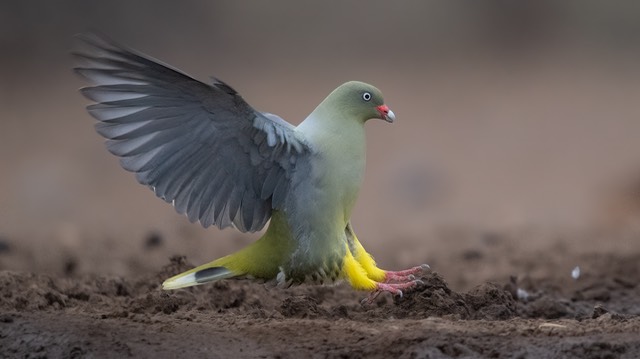


Despite having more pixels than my Z50, I find the X-S20 has about a half stop better dynamic range at the same ISO value. However, Fujifilm’s ISO interpretation is different than Nikon’s, so by the time you adjust each for the same exposure, the difference mostly disappears. Still, a gain of pixels without any real change in usable dynamic range is fine by me.
Most folk who gravitate to Fujifilm cameras do so because of the JPEG image quality (via the Film Simulations). Indeed, this is probably where the Fujifilm engineers are most connected to their customer: the Film Simulations have been intensely tested for customer response. Saturation, contrast, and skin tones are all carefully managed in ways that viewers respond to. Moreover, as with Nikon (which calls their approach Picture Controls), these JPEG renderings are consistent across all bodies. If you like the Provia choice on a GFX 100s, you’ll like it the same on an X-S20.
Final Words
For what I need in my casual use, the X-S20 manages to tick off quite a few boxes while only ticking me off in a few others.
Size and weight are fine, I love the articulating Rear LCD (can be folded so as to not be vulnerable when traveling), the image quality is what we all expect from Fujifilm these days (i.e. excellent), the range of options the X-S20 incorporates is great, it's a highly competent video camera, and the lens choices are well beyond what I had for the Nikon Z50. Moreover, it's solidly built, has a pop-up flash that's sometimes useful, and has a battery that provides it with some longevity compared to its competitors. With some configuration, simplification, and learning, I can make the camera do I what I want it to do and only be mildly irritated about the small controls and must-press-shutter-release-to-restore attribute.
The Achilles heels of the X-S20 are the small buttons, small EVF, menu organization, and the absolute focus performance.
Coming from an earlier X low-to-mid-range camera, even the X-S10, there’s a lot that’s new and better in the X-S20. Enough so that it’s worth upgrading if you're using an X-S10. Despite my comments about focus, the X-S20 is far better than the X-S10. It’s really that focus performance is a moving bar that other camera makers have moved further than Fujifilm has that’s the issue here.
The X-S20 is a very likable, but not lovable tool. It'll stick around in the gear closet as my casual camera until something better comes along.
Support this site by purchasing from the following advertiser:
